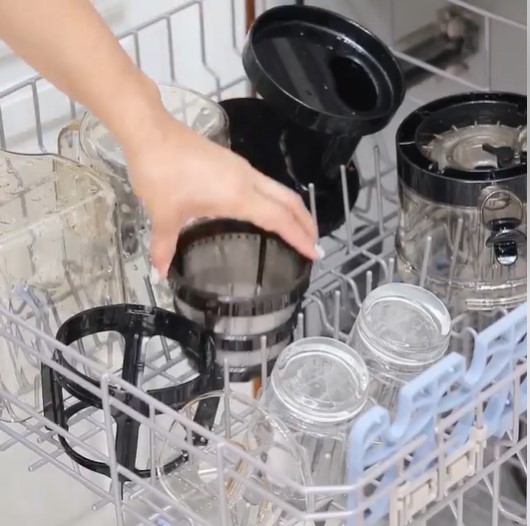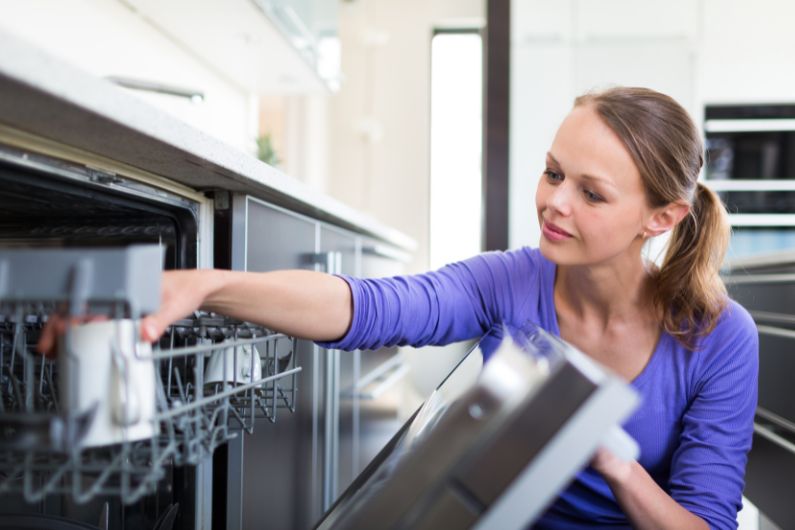Juicing has become a popular trend in recent years, thanks to its various health benefits. However, this healthy habit can come with a downside – cleaning the juicer. While some people prefer to hand wash their juicer components, others opt for the convenience of using a dishwasher. This raises the question – can your juicer handle the dishwasher?
In this blog post, we will explore the pros and cons of using a dishwasher to clean your juicer, and whether or not it’s safe for your appliance. We will discuss the different types of juicers and the materials they are made of, and their compatibility with dishwashers. We will also examine the potential risks of putting your juicer in the dishwasher, such as damage to the blades or motor, and any potential food residue left behind.
We will also offer helpful tips and tricks for maintaining your juicer’s cleanliness and longevity. This blog post is perfect for anyone who loves to juice and wants to know the best way to clean juicer parts.
Cleaning Of Juicer Parts – An Overview
When it comes to cleaning your juicer, it’s important to know which parts are safe to put in the dishwasher. Generally, juicers are made up of multiple parts, including a strainer, pulp container, and juice jug.
The good news is that many of these parts can be safely cleaned in the dishwasher, including the strainer, pulp container, and juice jug.
However, it’s important to note that not all juicer parts are dishwasher-safe, particularly those made from sensitive materials like plastic.
Get ready to juice up your knowledge! We’re here to break down all the different juicer parts and what they do. Plus, we’ve got the scoop on which parts you can safely toss in the dishwasher. So let’s dive into the juicy details together!
Different Types Of Juicer Parts
Listen up, juice lovers! When it comes to juicer machines, there are two main types: electrical and manual. But wait, there’s more! Electrical juicers can be further divided into two categories: centrifugal and masticating.
Sure, all juicers have some parts in common, such as the feeding chute, blades, strainer, pulp container, juice container, and motor base. But here’s the juicy part: each type of juicer has its own unique features and components. Let’s take a closer look at what sets them apart.
Parts Of Centrifugal Juicer
A centrifugal juicer is a popular kitchen appliance that extracts juice from fruits and vegetables quickly and efficiently.
The parts of a centrifugal juicer include –
- Motor,
- Cutting blade,
- Strainer,
- Pulp container,
- Juice container, and
- Feeding chute.
The motor is responsible for powering the cutting blade, which rotates at high speeds to extract juice from the produce.
The strainer separates the pulp from the juice, and the pulp container collects the leftover pulp.
The juice container holds the extracted juice, and the feeding chute is where to the produce is inserted.
Are All Parts Of A Centrifugal Juicer Dishwasher Safe?
When it comes to cleaning centrifugal juicers, the question of whether all parts are dishwasher safe is a common one. While most centrifugal juicers have some parts that are safe to clean in the dishwasher, it is important to carefully read the manufacturer’s instructions before attempting to clean any parts this way.
Some parts, such as the motor or electrical components, should never be immersed in water or put in the dishwasher. Additionally, some plastic parts may become warped or discolored if exposed to high heat in the dishwasher.
To ensure the longevity and safe use of your centrifugal juicer, follow the manufacturer’s recommendations for cleaning and maintenance.
Parts Of Masticating Juicer
A masticating juicer, also known as a slow juicer, is an advanced piece of kitchen equipment that is designed to extract juice from fruits and vegetables in a more efficient manner than traditional centrifugal juicers.
Parts of a masticating juicer include –
- Motor
- Feeding tube,
- Auger,
- Strainer,
- Collection cup,
- Pulp ejector spout
The feeding tube is where the fruits and vegetables are inserted, and it is wide enough to accommodate larger pieces.
The auger is responsible for crushing the produce and squeezing out the juice.
The strainer filters out any pulp or fiber, resulting in a smoother juice.
The collection cup collects and dispenses the juice.
And, the pulp ejector spout releases the pulp, which is collected in a separate container.
Are All Parts Of A Masticating Juicer Dishwasher Safe?
When it comes to cleaning a masticating juicer, it’s important to know which parts are dishwasher safe. While some models may have all-parts dishwasher safe, others may require hand washing for certain components.
It’s crucial to read the manufacturer’s instructions and guidelines before cleaning to avoid damaging any parts or reducing the juicer’s lifespan.
Generally, the juicer’s main body and motor should never be immersed in water, and parts such as the auger, screen, and housing should be carefully washed by hand.
By following the manufacturer’s cleaning instructions, you can ensure that your masticating juicer remains in optimal condition for producing healthy, delicious juice.
Parts Of A Manual Juicer
A manual juicer is a simple and effective kitchen tool for extracting juice from fruits and vegetables. It is made up of several parts, each with its own unique functionality.
The main parts of a manual juicer include
- The base,
- Handle,
- Juicing cone,
- Strainer, and
- Juice collector.
The base provides stability to the juicer, while the handle is used to apply pressure on the juicing cone, which extracts juice from the fruits and vegetables.
The strainer helps to remove any solid particles from the juice, while the juice collector collects the juice.
Are All Parts Of A Manual Juicer Dishwasher Safe?
When it comes to cleaning a manual juicer, many people wonder if all parts of the juicer is dishwasher safe. It is important to note that not all parts of a manual juicer are safe to be washed in a dishwasher.
While some parts are made with materials that can withstand high temperatures and harsh detergents, others are not.
It is essential to check the manufacturer’s instructions before placing any parts in the dishwasher.
In general, the base, handle, and other metal parts can be safely cleaned in the dishwasher. However, the juicing cone and other plastic parts may need to be washed by hand to prevent damage.
Centrifugal Vs Masticating Juicer: Which One Is More Dishwasher Friendly?
When it comes to juicing, choosing the right type of machine is crucial. Between centrifugal and masticating juicers, the latter is more dishwasher-safe.
Masticating juicers, also known as slow juicers, use a slower and more thorough process to extract juice from fruits and vegetables by crushing and pressing the produce against a mesh screen. This means there are fewer parts to clean and they are generally easier to disassemble and put back together.
Centrifugal juicers, on the other hand, work by spinning the produce at high speeds, which can lead to more pulp and debris getting stuck in the machine. This makes them more difficult to clean and less dishwasher-friendly.
Benefits Of Cleaning Your Juicer In The Dishwasher
Cleaning juicer parts in a dishwasher has several benefits that make it the preferred cleaning method for many households.
It helps to save time and effort compared to hand washing, as the dishwasher can clean a large number of parts all at once.
The high temperature of the dishwasher helps to eliminate any bacteria or germs that may be present on the juicer parts, ensuring a more hygienic juicing experience.
Also, it promotes hygiene and safety, as the dishwasher’s sanitizing cycle can help sterilize the parts, reducing the risk of contamination.
It extends the lifespan of the juicer by preventing the buildup of stubborn stains or deposits that can affect its performance over time.
Additionally, dishwasher-safe parts are often more durable and long-lasting, as they are designed to withstand the high heat and pressure of a dishwasher.
Overall, cleaning juicer parts in a dishwasher is a convenient, effective, and efficient way to maintain the cleanliness and hygiene of your juicing equipment.
Potential Problems With Cleaning Your Juicer In The Dishwasher
Cleaning your juicer in the dishwasher may seem like a convenient and efficient way to keep your appliance clean, but it comes with potential problems.
The high temperatures in the dishwasher can damage the plastic parts of the juicer, causing them to warp or crack. This can affect the performance of the appliance and may render it unusable.
Fruit and vegetable fibers can get stuck in the dishwasher’s filters, leading to clogs and reducing the machine’s effectiveness.
The dishwasher may not effectively clean all the nooks and crannies of the juicer, leaving behind residue that can contaminate future juices.
Additionally, the dishwasher can cause discoloration or rusting of some of the juicer’s parts, compromising its hygiene and safety.
Finally, harsh detergents and chemicals in dishwasher tablets can leave residue on the juicer, affecting the taste and quality of the juice.
It is best to clean your juicer manually with warm soapy water to ensure its longevity and optimal performance.
Tips To Clean Dishwasher-Safe Juicer Parts In A Dishwasher
Cleaning juicer parts can be a hassle, especially when it comes to the smaller components. However, cleaning your juicer parts in a dishwasher can save you time and effort.
To ensure that your juicer parts are properly cleaned in a dishwasher, there are a few tips to keep in mind.
First, make sure that the parts you’re going to put into the dishwasher are dishwasher-safe.
Then, disassemble the juicer and remove any large chunks of fruit or vegetables before placing the parts in the dishwasher. This will prevent clogging and ensure a thorough cleaning.
It is advisable to place the parts on the top rack of the dishwasher to avoid any damage from the heating element at the bottom of the machine.
Additionally, it’s important to use the correct cycle and temperature on your dishwasher.
Opt for a hot water cycle and avoid using any harsh detergents or abrasive cleaning tools that could damage the parts.
Finally, be sure to thoroughly dry the parts before reassembling and storing them to prevent any mold or bacteria growth.
By following these simple tips, you can keep your dishwasher-safe juicer parts clean and in good condition for years to come.

Tips To Clean Non-Dishwasher-Safe Juicer Parts
Cleaning non-dishwasher-safe juicer parts can be a daunting task, but with the right approach, it can be done quickly and effectively.
Firstly, disassemble the juicer and remove the parts that require cleaning. Rinse them thoroughly under running water to remove any excess pulp or juice.
Then, soak them in warm, soapy water for several minutes to loosen any remaining debris. Use a soft-bristled brush to gently scrub the parts, being careful not to damage any delicate components.
For tough stains, mix a solution of vinegar and water or baking soda and water, and let the parts soak for a few minutes.
Rinse the parts again under running water and dry them with a clean soft dishcloth.
To ensure all parts are fully sanitized, consider using a disinfectant wipe or spray.
With these simple tips, cleaning non-dishwasher-safe juicer parts can be a breeze.
Final Thought
In conclusion, cleaning the juicer parts is an important step in maintaining the quality of your juice and the longevity of your juicer. While using the dishwasher may be a convenient option, it is important to check the manufacturer’s instructions to ensure that the parts are dishwasher safe.
If they are not, it is best to wash them by hand using warm soapy water. By properly cleaning your juicer, you can continue to enjoy delicious and healthy juice for years to come.
Additional Resources
How To Clean Juicer Buildup?
How Does A Masticating Juicer Work?
Know The Different Types Of Juicers
What Are The Best Easy To Clean Juicers?

